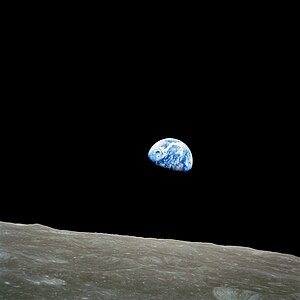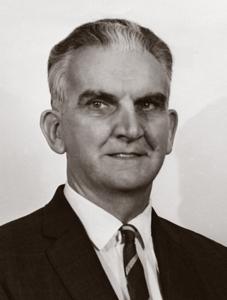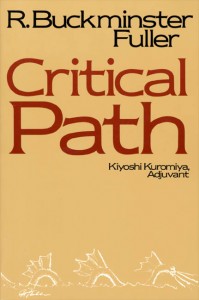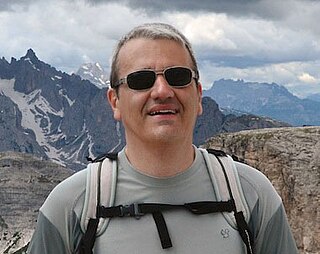

Spaceship Earth (or Spacecraft Earth or Spaceship Planet Earth) is a worldview encouraging everyone on Earth to act as a harmonious crew working toward the greater good.


Spaceship Earth (or Spacecraft Earth or Spaceship Planet Earth) is a worldview encouraging everyone on Earth to act as a harmonious crew working toward the greater good.
The earliest known use of the term [1] is a passage in Henry George's best known work, Progress and Poverty [2] (1879). From book IV, chapter 2:
It is a well-provisioned ship, this on which we sail through space. If the bread and beef above decks seem to grow scarce, we but open a hatch and there is a new supply, of which before we never dreamed. And very great command over the services of others comes to those who as the hatches are opened are permitted to say, "This is mine!"
Around the same time, Walt Whitman in Old Age Echoes ( Leaves of Grass , multiple editions between 1855 and 1891) associated:
"One thought ever at the fore—
That at the Divine Ship, the World, breathing Time and Space,
All peoples of the globe together sail, sail the same voyage, are bound to the same destination." [3]
George Orwell (known for writing the 1949 novel Nineteen Eighty-Four ) had earlier paraphrased Henry George in his 1937 book The Road to Wigan Pier :[ full citation needed ]
The world is a raft sailing through space with, potentially, plenty of provisions for everybody; the idea that we must all cooperate and see to it that everyone does his fair share of the work and gets his fair share of the provisions seems so blatantly obvious that one would say that no one could possibly fail to accept it unless he had some corrupt motive for clinging to the present system.
In 1965, Adlai Stevenson made a speech to the United Nations, in which he said:
We travel together, passengers on a little space ship, dependent on its vulnerable reserves of air and soil; all committed for our safety to its security and peace; preserved from annihilation only by the care, the work, and, I will say, the love we give our fragile craft. We cannot maintain it half fortunate, half miserable, half confident, half despairing, half slave—to the ancient enemies of man—half free in a liberation of resources undreamed of until this day. No craft, no crew can travel safely with such vast contradictions. On their resolution depends the survival of us all. [4]
The following year, Spaceship Earth became the title of a book by a friend of Stevenson's, the economist Barbara Ward.[ full citation needed ]
In 1966, Kenneth E. Boulding, who was influenced by reading Henry George's work, [5] used the phrase in the title of his essay, The Economics of the Coming Spaceship Earth. [6] Boulding described the past open economy of apparently illimitable resources, which he said he was tempted to call the "cowboy economy", and continued: "The closed economy of the future might similarly be called the 'spaceman' economy, in which the earth has become a single spaceship, without unlimited reservoirs of anything, either for extraction or for pollution, and in which, therefore, man must find his place in a cyclical ecological system". This "cowboys in a spaceship" theme would eventually be taken up by scholar David Korten in his 1995 book When Corporations Rule the World .
The phrase was also popularized by Buckminster Fuller, who authored the 1968 book Operating Manual for Spaceship Earth . [7] This quotation, referring to fossil fuels, reflects his approach:
... we can make all of humanity successful through science's world-engulfing industrial evolution provided that we are not so foolish as to continue to exhaust in a split second of astronomical history the orderly energy savings of billions of years' energy conservation aboard our Spaceship Earth. These energy savings have been put into our Spaceship's life-regeneration-guaranteeing bank account for use only in self-starter functions.
United Nations Secretary-General U Thant spoke of Spaceship Earth on Earth Day March 21, 1971 at the ceremony of the ringing of the Japanese Peace Bell: "May there only be peaceful and cheerful Earth Days to come for our beautiful Spaceship Earth as it continues to spin and circle in frigid space with its warm and fragile cargo of animate life." [8]
Spaceship Earth is the name given to the 50 m (160 ft) diameter geodesic sphere that greets visitors at the entrance of Walt Disney World's Epcot theme park. Housed within the sphere is a dark ride that serves to explore the history of communications and promote Epcot's founding principles, "[a] belief and pride in man's ability to shape a world that offers hope to people everywhere." [9] A previous incarnation of the ride, narrated by actor Jeremy Irons and revised in 2008, was explicit in its message:
Like a grand and miraculous spaceship, our planet has sailed through the universe of time, and for a brief moment, we have been among its many passengers... We now have the ability and the responsibility to build new bridges of acceptance and co-operation between us, to create a better world for ourselves and our children as we continue our amazing journey aboard Spaceship Earth. [10]
The term "Spaceship Earth" is frequently used on the labels of Emanuel Bronner's products to emphasize and promote his belief in the unity of humankind.

Richard Buckminster Fuller was an American architect, systems theorist, writer, designer, inventor, philosopher, and futurist. He styled his name as R. Buckminster Fuller in his writings, publishing more than 30 books and coining or popularizing such terms as "Spaceship Earth", "Dymaxion", "ephemeralization", "synergetics", and "tensegrity".

Epcot, stylized in all uppercase as EPCOT, is a theme park at the Walt Disney World resort in Bay Lake, Florida. It is owned and operated by The Walt Disney Company through its Disney Experiences division. The park opened on October 1, 1982, as EPCOT Center, the second of four theme parks built at the resort. Often referred to as a "permanent world's fair", Epcot is dedicated to the celebration of human achievement, particularly technological innovation and international culture.

Herman Edward Daly was an American ecological and Georgist economist and professor at the School of Public Policy of University of Maryland, College Park in the United States, best known for his time as a senior economist at the World Bank from 1988 to 1994. In 1996, he was awarded the Right Livelihood Award for "defining a path of ecological economics that integrates the key elements of ethics, quality of life, environment and community."

Horizons was a dark ride attraction at Epcot, a theme park at Walt Disney World in Bay Lake, Florida. Located on the eastern side of the Future World section of Epcot, the attraction used Disney's Omnimover system, but unlike most omnimover systems, it was suspended from a track above, which took guests past show scenes depicting visions of the future. It is believed to be the sequel to Walt Disney's Carousel of Progress, an attraction in Tomorrowland at Walt Disney World's Magic Kingdom. Horizons was the only attraction in Future World to showcase all of Epcot's "Future World" elements: communication, energy, transportation, anatomy, along with humankind's relationship to the sea, and the land.

Spaceship Earth is a dark ride attraction at the EPCOT theme park at the Walt Disney World in Bay Lake, Florida. The geodesic sphere in which the attraction is housed has served as the symbolic structure of EPCOT since the park opened in 1982.

A steady-state economy is an economy made up of a constant stock of physical wealth (capital) and a constant population size. In effect, such an economy does not grow in the course of time. The term usually refers to the national economy of a particular country, but it is also applicable to the economic system of a city, a region, or the entire world. Early in the history of economic thought, classical economist Adam Smith of the 18th century developed the concept of a stationary state of an economy: Smith believed that any national economy in the world would sooner or later settle in a final state of stationarity.

CommuniCore was a pavilion dedicated to technological advance located at EPCOT Center in Walt Disney World, Florida. It occupied two semi-circular buildings behind Spaceship Earth at the center of Future World. The two buildings were known as CommuniCore East and West and housed rotating exhibits. The pavilion was closed and redesigned in 1994, and the former CommuniCore buildings became the home of Innoventions, which closed permanently on September 7, 2019.

IllumiNations: Reflections of Earth was a nighttime show performed nightly at Epcot at the Walt Disney World Resort in Bay Lake, Florida. The show utilized fireworks, pyrotechnics, water fountains, fire effects, lasers, searchlights, and a large rotating globe with curved LED screens to create a visual production on the park's World Showcase Lagoon.

WestCOT was a planned second theme park for the Disneyland Resort in Anaheim, California. It was essentially a replica of EPCOT Center at the Walt Disney World Resort in Lake Buena Vista, Florida, and was dedicated to the celebration of human achievement, namely technological innovation and international culture. The park was represented by SpaceStation Earth, a larger version of the geodesic sphere Spaceship Earth featured at EPCOT Center.

Operating Manual For Spaceship Earth is a short book by R. Buckminster Fuller, first published in 1969, following an address with a similar title given to the 50th annual convention of the American Planners Association in the Shoreham Hotel, Washington D.C., on 16 October 1967.

The Walt Disney World Millennium Celebration was an event at the Walt Disney World Resort as part of millennium celebrations held around the world. Running from October 1, 1999 to January 1, 2001, the celebration was primarily based at Epcot, with its emphasis on human potential and the possibilities of the future.
IllumiNations was a series of nightly fireworks shows at Epcot before IllumiNations: Reflections of Earth was created in 1999 for the Walt Disney World Millennium Celebration.

Kenneth Ewart Boulding was an English-born American economist, educator, peace activist, and interdisciplinary philosopher. Boulding was the author of two citation classics: The Image: Knowledge in Life and Society (1956) and Conflict and Defense: A General Theory (1962). He was co-founder of general systems theory and founder of numerous ongoing intellectual projects in economics and social science. He was married to sociologist Elise M. Boulding.

Critical Path is a book written by US author and inventor R. Buckminster Fuller with the assistance of Kiyoshi Kuromiya. First published in 1981, it is alongside Operating Manual for Spaceship Earth one of Fuller's best-known works. Vast in its scope, it describes Fuller's own vision of the development of human civilization, economic history, and his highly original economic ideology based, amongst other things, on his detailed description of why scarcity of resources need no longer be a decisive factor in global politics.
Luigi Gussalli (1885–1950), engineer and inventor, was a pioneer of motor cars. He turned to astronautics in the 1920s, corresponding with world leaders in this field, such as Oberth and Goddard and exchanging with them theories on interplanetary flight and its prospects. He developed a special double-reaction engine, wrote extensively on multi-stage rockets and published two books on space travel. The first one, in 1923, described a space flight to the Moon, the second one, written in 1946, is even more astonishing in its theme: “Interplanetary travels by means of solar radiations”.

Captain EO is a 1986 American 3D science fiction short film shown at Disney theme parks from 1986 until 1998. The movie, starring Michael Jackson, was written by George Lucas, and directed by Francis Ford Coppola. The film was shown as part of an attraction with in-theater effects. The attraction returned to the Disney Parks in 2010 as a tribute after Jackson's death. The film was shown for the final time at Epcot on December 6, 2015.

Vincenzo Balzani is an Italian chemist, now emeritus professor at the University of Bologna.

Nicola Armaroli is an Italian chemist, research director at the Italian National Research Council (CNR), director of the scientific magazine Sapere and member of the Italian National Academy of Sciences.

Epcot Forever was a limited-time fireworks show that premiered on October 1, 2019, at Epcot. Epcot Forever served as an interim replacement for IllumiNations: Reflections of Earth until its long-term replacement, Harmonious, premiered in 2021. It took the form of a celebration of Epcot's musical history. The show celebrated the park's 37-year history, featuring fireworks, music, lighting, lasers, and special effects kites set to new arrangements of music originating from some of the park's classic attractions, such as Journey Into Imagination, Spaceship Earth, Soarin', Tapestry of Nations and Universe of Energy. The show was also made to celebrate the past, present, and future of Epcot.